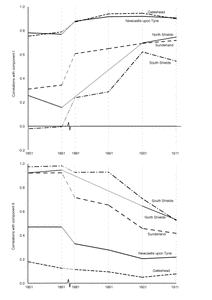Barke, Mike and Taylor, Peter (2015) Newcastle's long nineteenth century: a world-historical interpretation of making a multi-nodal city region. Urban History, 42 (1). pp. 43-69. ISSN 0963-9268
|
PDF
Newcastle19C.pdf - Accepted Version Download (459kB) | Preview |
|
![[img]](/18384/2.hassmallThumbnailVersion/NCL_19C_Figure_1.jpg)
|
Image (JPEG) (Figure 1)
NCL_19C_Figure_1.jpg - Supplemental Material Download (80kB) | Preview |
Abstract
We describe and analyse how Newcastle was transformed from a relatively stagnant British city at the dawn of the nineteenth century to one of the most vibrant cities in the world by the early twentieth century. We use two frameworks to chart and explain this momentous change: Wallerstein's model of hegemonic cycles to locate Newcastle's late development in a world-historical context, and Jacobs’ theory of city economic growth to understand the processes of change within the city and its region. These lead to an empirical focus on three investigations: first, how Newcastle grew geographically to become a multi-nodal city region (Tyneside plus Wearside); second, how the Newcastle city economy grew and developed into a very complex division of labour; and third, how this generated a new modern metropolitan cultural world.
| Item Type: | Article |
|---|---|
| Additional Information: | first published online. 8 September 2014 |
| Uncontrolled Keywords: | economic growth; economic history; empirical analysis; hegemony; labor division; metropolitan area; nineteenth century; urban economy; urban history; Newcastle |
| Subjects: | V100 History by period V200 History by area |
| Department: | Faculties > Arts, Design and Social Sciences > Social Sciences Faculties > Engineering and Environment > Geography and Environmental Sciences |
| Depositing User: | Users 6424 not found. |
| Date Deposited: | 04 Dec 2014 14:06 |
| Last Modified: | 01 Aug 2021 04:35 |
| URI: | http://nrl.northumbria.ac.uk/id/eprint/18384 |
Downloads
Downloads per month over past year







